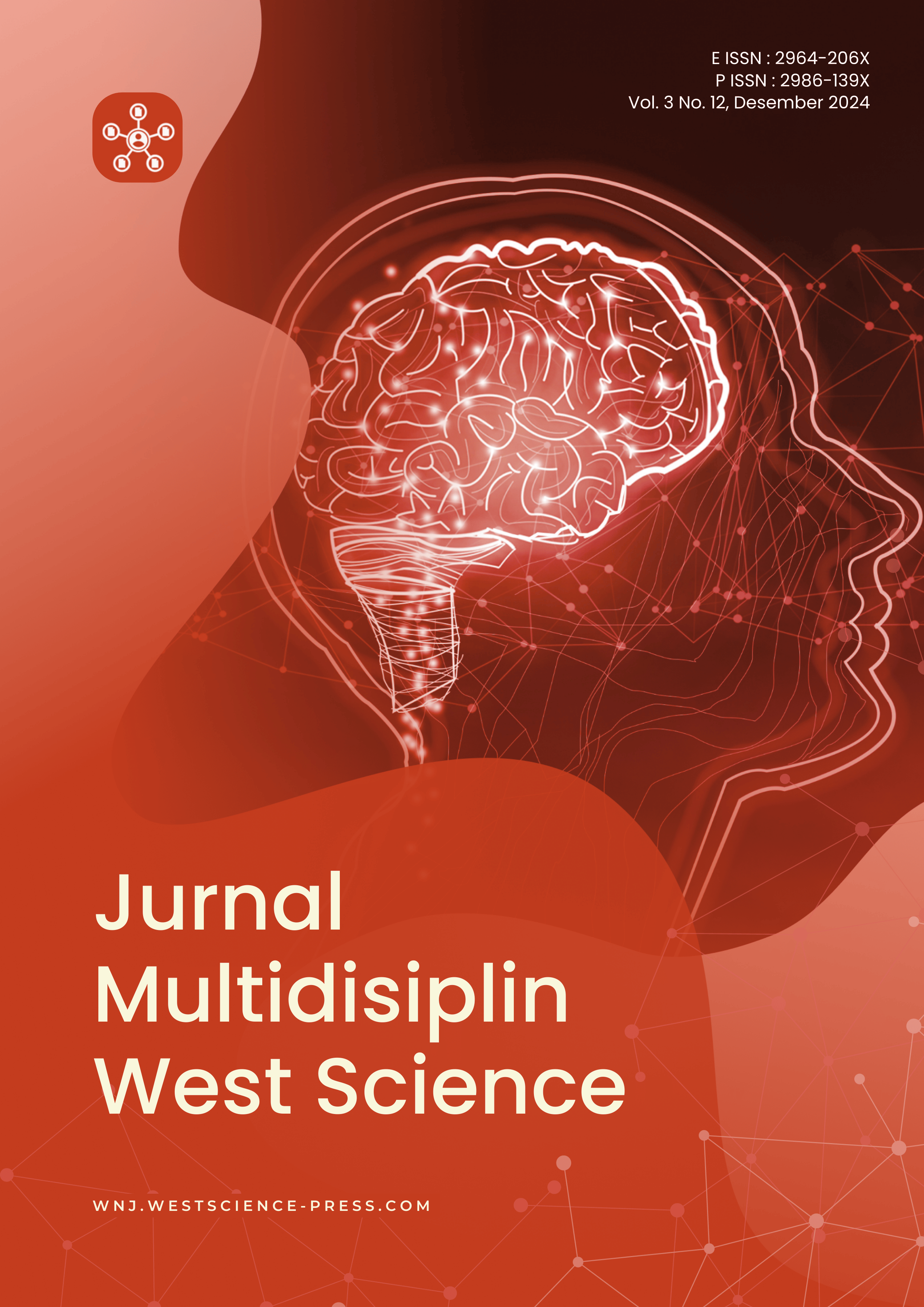The Psycholinguistics Approach: Contributions to English Language Pedagogy
DOI:
https://doi.org/10.58812/jmws.v3i12.1775Kata Kunci:
Psycholinguistics, Approach, English Language, PedagogyAbstrak
Psycholinguistics is a study which explains how a person acquires, produces, and perceives language both orally and in writing. Moreover, psycholinguistics is a branch of cognitive science and one of the issues that has become a trending topic in cognitive science is the mind and its role in language use and acquisition. By understanding psycholinguistics, at least we know what processes occur in the mind related to language acquisition, what problems are experienced by a person's mind in the process of language acquisition. Of course, these types of information will provide many contributions for language teachers as well as curriculum and teaching material designers in streamlining the language teaching process, especially foreign languages. Contribution in this context refers to everything that psycholinguistics has provided and has been the cause of improvement or progress in the area of language pedagogy (learning and teaching). To find out what these contributions are, the author has conducted a literature review by reading a variety of published opinions from psycholinguistic experts. At least, two types of contributions can be identified, namely theoretical contributions and practical contributions. Corley, K. G., & Gioia, D. A. (2011) refer to these two types of contributions as ‘scientific utility’ and ‘practical utility’.
Referensi
Akhmedova, Z. (2022). Development Of Active and Passive Vocabulary In Preschool Children With Motor Alalia Using Art Therapy Elements. Ann. For. Res, 65(1), 7148-7161.
Andi, K., & Arafah, B. (2017). Using needs analysis to develop English teaching materials in initial speaking skills for Indonesian college students of English. The Turkish Online Journal of Design, Art and Communication (TOJDAC), Special Edition, 6(9), 419-436.
Alqahtani, M. (2015). The importance of vocabulary in language learning and how to be taught. International journal of teaching and education, 3(3), 21-34.
Alzamil, J. (2021). Listening Skills: Important but Difficult to Learn. Arab World English Journal, 12 (3) 366-374. DOI: https://dx.doi.org/10.24093/awej/vol12no3.25
Arafah, H. B., & Bahar, A. K. (2015). The art of developing speaking as a performance (promoting formal uses of public speaking skills in english for making speeches and oral presentation). Yogyakarta: Trust Media.
Arafah, B., & Kaharuddin, (2019). The Representation of Complaints in English and Indonesian Discourses. Opción, 35, 501-517
Arafah, B., Kaharuddin, K., Takwa, T., Arafah, N. B., Kadaruddin, K., & Marlina Raja Leba, S. (2021a). Promoting the Building up of Character Education Based on Literature, Culture, and Local Wisdom. Linguistica Antverpiensia. 1, 2129-2147.
Arafah, B., Kaharuddin, K., Mulyanto, M., Arifin, M. B., Rofikah, U., & B Ara-fah, A. (2021b). The idol: An innovative model for designing literature-based ELT materials. Linguistica Antverpiensia. 1, 2075-2090
Bacon, S. M. (1992). Phases of listening to authentic input in Spanish: A descriptive study. Foreign Language Annals, 25(4), 317-333.
Bahar, A. K. (2013). The Communicative Competence-Based English Language Teaching. Yogyakarta: TrustMedia.
Bahar, K. (2014a). Interactional Speaking a Guide to enchance Natural Communication Skills in English. Yogyakarta: TrustMedia.
Bahar, A. K. (2014b). Transactional Speaking: A Guide to Improve Transactional Exchange Skills in English for Group Discussions (GD) and Interviews. Samata Gowa: Gunadarma Ilmu.
Bahar, K. (2013). The communicative grammar translation method: An integrated method of CLT and GT for teaching English communicatively and accurately. Yogyakarta: Trustmedia.
Bahar, A. K., & Latif, I. (2019). Society-based English community (sobat): EFL learners’strategy in learning and practicing English outside the walls. Jurnal ilmu budaya, 7(2), 255-265.
Bakhromova, A., & Ergashev, M. (2022). Suggestopedia As an Important Method of Teaching Vocabulary. Central Asian Journal of Literature, Philosophy and Culture, 3(6), 91-93.
Bancroft, W. J. (2005). Suggestopedia and language. Routledge: London
Bromley, K. (2007). Nine things every teacher should know about words and vocabulary instruction. Journal of adolescent & adult literacy, 50(7), 528-537.
Butarbutar, R., Arafah, B., Marlina Raja Leba, S., Kaharuddin, K., F Sauhenda, A., & Monika, S. (2021). Using mobile-assisted language to encourage EFL learning among Indonesian learners of English. Linguistica Antverpiensia. 2. 766-779
Cardenas Claros, M. S. (2008). Psycho-linguistic and socio-cultural approaches to language learning: A never ending debate. Colombian Applied Linguistics Journal, (10), 142-154.
Carroll, D.W. (2008). Psychology of Language. 5th ed., USA: Thomson Wadsworth.
Chafe, W. L. (1968). Idiomaticity As an Anomaly in The Chomskyan Paradigm. Foundations of language, 109-127.
Chen, J., Nairn, R., & Chi, E. (2011, May). Speak little and well: recommending conversations in online social streams. In Proceedings of the SIGCHI Conference on Human Factors in Computing Systems (pp. 217-226).
Corley, K. G., & Gioia, D. A. (2011). Building theory about theory building: what constitutes a theoretical contribution? Academy of management review, 36(1), 12-32.
Dardjowidjojo, S. (2005). Psikolinguistik: Pengantar Pemahaman Bahasa Manusia. Jakarta: Yayasan Obor Indonesia.
Darti, D., & Asmawati, A. (2017). Analyzing students’ difficulties toward listening comprehension. English, Teaching, Learning, and Research Journal, 3(2) 211-228. https://doi.org/10.24252/Eternal.V32.2017.A9
Davies, N. F. (1976). Receptive versus productive skills in foreign language learning. The Modern Language Journal, 60(8), 440-443.
Demirezen, M. (2004). Relations between psycholinguistic approach and foreign language learning and teaching. Ondokuz Mayis University Journal of Education Faculty, 17(1), 33-44.
Dey, M. (2021). Psychological processes in language learning and teaching: Scoping review and future research directions. Journal of Psychological Perspective, 3(2), 105-110.
Dey, M., & Sawalmeh, M. H. (2021). Psychological Processes in Language Learning and Teaching: Methods and Approaches of Psycholinguistics. British Journal of Applied Linguistics, 1(1), 01-07.
Eyring, H. B. (1988). Listen Together. Brigham Young University Media Services.
Fan, M. (2000). How big is the gap and how to narrow it? An investigation into the active and passive vocabulary knowledge of L2 learners. Relc journal, 31(2), 105-119.
Field, J. (2004). Psycholinguistics: The key concepts. London: Routledge
Garrett, M. (1980). Levels of processing in sentence production. In Language production Vol. 1: Speech and talk (pp. 177-220). Academic Press.
Gilakjani, A. P. (2016). What factors influence the English pronunciation of EFL learners?. Modern Journal of Language Teaching Methods, 6(2), 314-326.
Harley, T. (2006). Speech errors: Psycholinguistic approach. Invited entry in K. Brown (Ed.), The Encyclopaedia of Language and Linguistics (2nd. Ed., Vol. 11: pp. 739-744), Oxford: Elsevier.
Havron, N., & Arnon, I. (2021). Starting big: The effect of unit size on language learning in children and adults. Journal of Child Language, 48(2), 244-260.
Ismail., Sunubi, A. H., Halidin, A., & Kaharuddin, A. (2020). Paraphrasing Technique To Develop Skill for English Writing Among Indonesian College Students of English. Sys Rev Pharm, 11(11), 291-297.
Ivanova, G., & Dimova-Severinova, D. (2021). The Role of Happiness in Applying Suggestopedia and Fostering the Language Learning Process. Journal of Social Studies Education Research, 12(4), 365-383.
Kadaruddin, Arafah, B., Ahmad, D., Kaharuddin, Iska.(2020). Word Wall Media: An Effective Teaching Technique to Enrich Students' Vocabulary in Secondary Level of Education, International Journal of Advanced Science and Technology, 29(5), 13228-13242.
Kaharuddin, K. (2016). Detecting Errors in English Made by Intermediate Indonesian Learners of English in English Department Students of STAIN Parepare. KURIOSITAS: Media Komunikasi Sosial dan Keagamaan, 9(1), 1-19.
Kaharuddin, A., & Latif, I. (2017). The Essential of Discourse Analysis for Teaching English as a Foreign Language. Yogyakarta: Trust Media Publishing.
Kaharuddin, & Hasyim, M. (2020). The speech act of complaint: socio-cultural competence used by native speakers of english and indonesian. International Journal of Psychosocial Rehabilitation, 24(06).14016-14028
Kaharuddin, et al. (2014). Communicative Competence-Based Syllabus Design for Initial English Speaking Skills. International Journal of Enhanced Research in Educational Development (IJERED), www.erpublications.com, 2 (3), 64-83.
Kaharuddin & Nanning, (2014). The problems of Indonesian college EFL learners in listening comprehension. Jurnal ilmu budaya, 2(2), 40-51.
Kaharuddin, A. (2018). The communicative grammar translation method: a practical method to teach communication skills of English. ETERNAL (English, Teaching, Learning, and Research Journal), 4(2), 232-254.
Kaharuddin, A., & Ahmad, D. (2018). English Phonetics for Indonesian Learners of English (An Essential Guide to Natural English Pronuncitation), Yogyakarta: TrustMedia.
Kaharuddin, A. (2019). The Power of English: Recognizing and Utilizing the Tremendous Impact of the English Language on the Community. English Language Teaching for EFL Learners, 1(1), 39-48.
Kaharuddin, Hikmawati & Arafah, B. (2019). Needs Analysis on English for Vocational Purpose for Students of Hospitality Department. KnE Social Sciences, 344-387.
Kaharuddin, A. Ahmad, D., Mardiana, & Rusni. (2020). Contributions of technology, culture, and attitude to English learning motivation during COVID-19 outbreaks. Systematic Reviews in Pharmacy, 11(11), 76-84.
Kaharuddin, Hasyim, M., Kaharuddin, Tahir, M., Nurjaya, M,. (2020). Problematic English Segmental Sounds: Evidence from Indonesian Learners of English. Palarch’s Journal of Archaeology of Egypt/Egyptology 17(6). 9105-9114.
Kaharuddin, K., & Rahmadana, A. (2020). Problem-Based Group Discussion: An Effective ELT Technique To Improve Vocational High School Students’transactional Speaking Skills. Jurnal Ilmu Budaya, 8(2), 247-258.
Kaharuddin, K. (2021). Assessing the effect of using artificial intelligence on the writing skill of Indonesian learners of English. Linguistics and Culture Review, 5(1), 288-304.
Kaharuddin. (2021). Linguistics: Basic Theory and Roles in English Language Teaching. Jakarta: Prenada Media.
Kaharuddin, K., & Ismail, I. (2022). The use of ‘I-Do’methodology in integrating moral characters into the development of ELT materials for transactional speaking skills. Linguistics and Culture Review, 6(1), 1-29.
Kaharuddin, M., Ahmad, D., & Sari, A. A. I. (2022). Examining the skill in writing descriptive text among Indonesian learners of English: The effects of task-based language teaching (TBLT). Journal of Language Teaching and Research, 13(1), 46-57.
Kaharuddin, Arafah., B, Nurpahmi, S., Sukmawaty, I. F. R., & Juniardi, Y. (2023). Exploring How Reading Aloud and Vocabulary Enrichment Shape English Speaking Skills Among Indonesian Learners of English. World Journal of English language, 13(8). 436-445.
Kaharuddin, Ahmad, D., Mardiana., Latif, I., Arafah, B., & Suryadi, R. (2024). Defining the Role of Artificial Intelligence in Improving English Writing Skills among Indonesian Students. Journal of Language Teaching and Research, 15(2), 568-678.
Konopka, A. E., & Bock, K. (2009). Lexical or syntactic control of sentence formulation? Structural generalizations from idiom production. Cognitive Psychology, 58(1), 68-101.
Krashen, S. (1985). The input hypothesis: Issues and implications. London: Longman.
Krashen, S. D., & Terrell, T. (1983). Natural approach (pp. 178-191). New York: Pergamon.
Laufer, B., & Paribakht, T. S. (1998). The relationship between passive and active vocabularies: Effects of languagelearning context. Language learning, 48(3), 365-391.
Mardiana, Arafah, B., Ahmad, D., Kaharuddin., Room, F., & Barus, E. (2023). Time Allocation Effect on Test Scores for Academic Writing of Indonesian English Learners. Journal of Language Teaching and Research, 14(6), 1628-1636.
Marinis, T. and Cunnings, I. (2018) Using psycholinguistic techniques in a second language teaching setting. In: Wright, C., Piske, T. and Young-Scholten, M. (eds.) Mind matters in SLA. Multilingual Matters, Bristol, pp. 185-202.
McDonough, D. (2013). Similarities and differences between adult and child learners as participants in the natural learning process. Psychology, 4(03), 345.
Mirza, S. B. (2021). Role of Motivation in English Language Learning: A Real Challenge. The Creative launcher, 6(4), 224-229.
Nemati, A. (2010). Active and passive vocabulary knowledge: The effect of years of instruction. The Asian EFL Journal Quarterly, 12(1), 30-46.
Newlin, P., & Moss, J. (2020). Proceduralization and Working Memory in Association Learning. In CogSci.
O'Malley, J. M., Chamot, A. U., & Küpper, L. (1989). Listening comprehension strategies in second language acquisition. Applied linguistics, 10(4), 418-437.
Rixon, S. (1981). The design of materials to foster particular linguistic skills. The teaching of listening comprehension.(ERIC Document Reproduction Service No. ED 258 465).
Richards, J. C., & Rodgers, T. (1982). Method: Approach, design, and procedure. Tesol Quarterly, 16(2), 153-168.
Richards, J. C., & Rodgers, T. S. (2014). Approaches and methods in language teaching. Cambridge university press.
Robert, N. (March 2. 2023). What are the mental faculties? And how to master them to change our life? Retrieved on November 22, 2023. https://www.linkedin.com/pulse/what-mental-faculties-how-master-them-change-our-life-nina-robert
Rofikah, U., Arafah, B., & Kaharuddin, A. (2022). Needs analysis as the cornerstone of the design and development of online language learning. Jurnal ilmu budaya, 10(1), 67-78.
Rustipa, K. (2011). Suggestopedia: How does it Accelerate Language Learning. LITE: Jurnal Bahasa, Sastra, dan Budaya, 7(1), 1-7.
Steinberg, D., Nagata, H., & Aline, D. (2013). Psycholinguistics: Language, mind and world. Routledge.
Suryani, L., & Argawati, N. O. (2018). Risk-taking and students’ speaking ability: do they correlate?. ELTIN journal: Journal of English Language Teaching in Indonesia, 6(1), 34-45.
Suwarna, S. (1992). Pembetulan Kesalahan dalam Pengajaran Bahasa Kedua. Jurnal Cakrawala Pendidikan, 2(2). 125-136.
Terrell, T. D. (1986). Acquisition in the natural approach: The binding/access framework. The Modern Language Journal, 70(3), 213-227.
Van Dijk, T. A. (1977). Sentence topic and discourse topic. Papers in Slavic philology, 1(1977), 49-61.
Warren, P. (2013). Introducing psycholinguistics. Cambridge University Press.
Wilde, S., & Larson, J. (2007). Listen. It’s Good for Kids. AudioFile, 23-25, URL: http://www.audiofilemagazine.com/content/uploaded/media/listen-goodforkids.pdf
Yassi, A. H. & kaharuddin. (2018). Syllabus Design of English Language Teaching. Prenada Media. Jakarta
Unduhan
Diterbitkan
Cara Mengutip
Terbitan
Bagian
Lisensi
Hak Cipta (c) 2024 Kaharuddin Kaharuddin

Artikel ini berlisensiCreative Commons Attribution-ShareAlike 4.0 International License.



















 Instagram
Instagram 